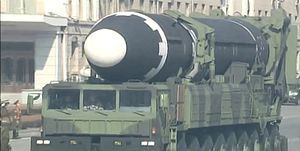North Korea hinted at the introduction of “another strategic weapon” in a statement attributed to Pak Jong Chon, the chief of the General Staff of the Korean People’s Army, North Korea’s armed forces. The statement was released on December 15, one day after the country’s Academy of National Defense Science announced that a “crucial” test had been conducted at the Sohae Satellite Launching Ground on the country’s west coast.
“I am very glad that the Academy of Defence Science has recently registered great successes in bolstering up the defence capabilities while successfully conducting tests of great significance one after another,” Pak said in the statement, which appeared in the Korean Central News Agency, North Korea’s external state media.
Pak’s statement was released as Stephen E. Biegun, the U.S. envoy for North Korea, arrived in Seoul, South Korea, to meet with his South Korean counterparts.
“The priceless data, experience and new technologies gained in the recent tests of defense science research will be fully applied to the development of another strategic weapon of the DPRK for definitely and reliably restraining and overpowering the nuclear threat of the U.S.,” the statement added.
North Korea describes long-range, nuclear-capable ballistic missiles as “strategic” weapons in its arsenal. In 2017, for the first time, North Korean flight-tested intercontinental-range ballistic missiles capable of reaching the United States, including the Hwasong-14, which was successfully flight-tested twice, and the Hwasong-15, which was successfully flight-tested once.
The statement underscored the importance of capabilities in North Korea’s arsenal. Using a term favored by senior North Korean officials in late-2017, Pak made reference to “the balance of power” — in essence, stable nuclear deterrence with the United States.
“Genuine peace can be safeguarded and our development and future be guaranteed only when the balance of power is completely ensured,” he said. Pak did not offer any direct evidence of what capabilities North Korea might look to demonstrate in due course, but he added that North Korea had ”stored up tremendous power,” possibly referring to capabilities that had been quietly developed while North Korean leader Kim Jong Un turned to diplomacy with South Korea and the United States in 2018 and 2019.
“We should be ready to cope with political and military provocations of the hostile forces and be familiar with both dialogue and confrontation,” the statement added.
Pak’s statement adds to a series of North Korean statements in November and December 2019 indicating a more confrontational stance by Pyongyang. A senior North Korean official suggested that the United States would receive a “Christmas gift.“ Recent test activity at Sohae, thought to be related to the testing of large liquid propellant engines for ballistic missiles or space launch vehicles, may indicate a launch before the end of the year.
North Korea has also announced that a fifth plenum of the 7th Central Committee of the Workers’ Party of Korea will convene in Pyongyang before the end of the year. On January 1, Kim Jong Un is expected to deliver his customary New Year’s Day address, in which he will outline objectives for the year ahead.

































